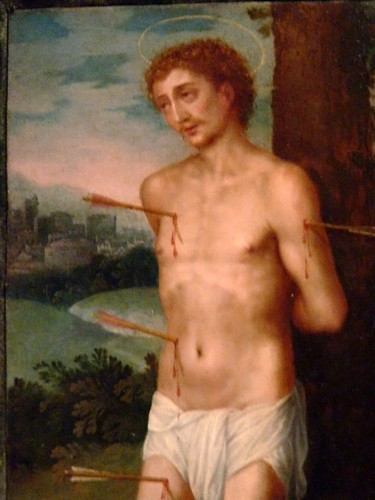 I decided to write The Splinter for a whole bunch of reasons. The trigger was that the writing list, ERWA, where I was acting as theme story editor, has a regular theme story competition and I was having to write the guidelines for the monthly themes. One of them was on religion and myth. In writing the parameters for the story call, I thought about what kind of stories intrigued me, so I began to do some research on the topic. In my wanderings, I ran across Butler's Lives of the Saints, and then St. Teresa of Avila.
I decided to write The Splinter for a whole bunch of reasons. The trigger was that the writing list, ERWA, where I was acting as theme story editor, has a regular theme story competition and I was having to write the guidelines for the monthly themes. One of them was on religion and myth. In writing the parameters for the story call, I thought about what kind of stories intrigued me, so I began to do some research on the topic. In my wanderings, I ran across Butler's Lives of the Saints, and then St. Teresa of Avila.After reading her autobiography: The Life of St. Teresa of Jesus, it occurred to me to take a step back from the revulsion I felt about this woman who, by all accounts, tortured herself into an ecstatic state throughout most of her life. It was easy to write her off as a delusional woman suffering from some mental illness. It would have been easy to blame it on the sexist, repressive sub-culture of the Church, within a sexist, repressive culture of 16th Century Spain.
I'd studied 16th Century Spain during my Spanish A' Levels and I'd read "Lazarillo de Tormes" in the original Spanish. I knew quite a lot about what society was like during the period. Catholic Spain still had the memory of Moorish occupation fresh in their minds. The city of Granada had only been reconquered in 1492. The Spanish Inquisition, which had started only 20 years earlier, and lasted until almost the 18th Century, was in full swing. It was a time of religious intolerance, and hyper-Catholicism. Nonetheless, most Spanish women weren't flagellating themselves to bloody pulps. What was so attractive about it to St. Teresa?
 What, I wondered, did she get out of all that pain? What was she searching for? What was the payoff? No one, no matter how mentally ill, keeps on hurting themselves over years unless they are achieving something by doing it. I started investigating other saints who had gained notoriety for their excessive acts of mortification.
What, I wondered, did she get out of all that pain? What was she searching for? What was the payoff? No one, no matter how mentally ill, keeps on hurting themselves over years unless they are achieving something by doing it. I started investigating other saints who had gained notoriety for their excessive acts of mortification.The idea grew in my mind: what if there were a modern-day St. Teresa? How would her family, her friends, the Church treat her? How could modern words be put to that great yearning for unity with God sought after by the self-mortifying Saints?
The idea for the story of The Splinter grew out of this.
References:
Butler, Alban. "Lives of the Saints." Sacred Texts. 1894. 15 Apr 2008
http://www.sacred-texts.com/chr/lots/index.htm
St. Catherine of Siena, "The Dialogue of Saint Catherine." Intratext Library. Unknown. 15 Apr 2008 http://www.intratext.com/IXT/ENG0139/_P1X.HTM.
St Teresa of Avila, "The Interior Castle - Six Mansions." Catholic First. Unknown. 15 Apr 2008 http://www.catholicfirst.com/thefaith/catholicclassics/stteresa/castle/interiorcastle4.cfm.
St. John of the Cross, "Ascent of Mount Carmel." Catholic First. unknown. 15 Apr 2008 http://www.catholicfirst.com/thefaith/catholicclassics/johnofthecross/ascent/ascent03.cfm.
400 words (2,821 and counting)

No comments:
Post a Comment